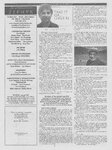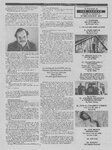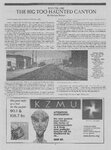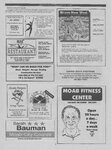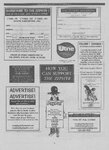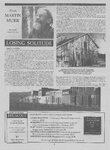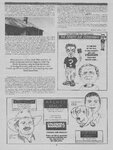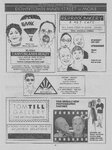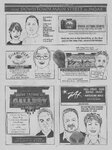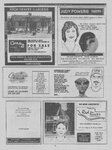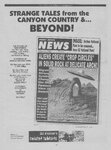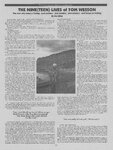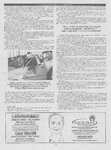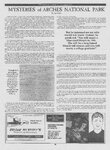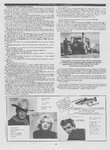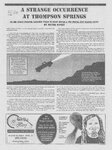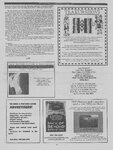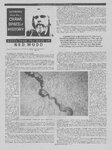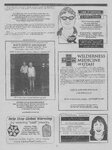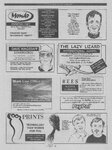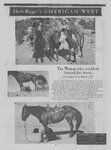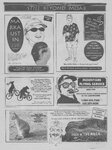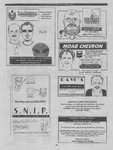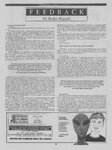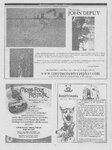| OCR Text |
Show THE ZEPHYR/OCTOBER-NOVEMBER 2007 out of landfill stuff, at the edge of Jackson's “dump.” That’s what we called it. “Landfill,” the euphemism, came later when our civilization began to smother under gigantic heaps of garbage and throw-aways. Kids burned down the house that the man we called “Injun Jack” built. Homeless, he built again. The town did nothing. No inquiries, his word against nameless kids. He disappeared. What was his real name? How did he lose out in the competition for place? Where did he go? What kind of man was he? Who were those ancient canyon people? Where did they come from? What stars did they steer by? Where did they go? Archaeologists have theories. The theories keep changing. I’m still wondering. On a trail at the STS ranch, I came across the remains of a one-room cabin in the woods. Returning to the ranch house I asked Buster and Frances Estes if anyone had lived there. Oh yes, Haywire Jimmy, and his family, spent a winter there, running a trapline. Frances said that Jimmy picked up the name “Haywire” because he was a bit tetched in the head, but Buster corrected her. “No, Slim, it was because when he had a job he always tied up his lunch with haywire.” (Baling wire; the early hay balers used wire, not twine). From MARTIN MURIE I went back to that fallen-in cabin, tried to imagine a family spending a long winter skerihog@ trapped inder the snow, like bears trying to hibernate. In the early days people did live like that, tolerating each other, surviving. Why? Because there was no choice, that’s why. westelcom.com LOSING SOLITUDE EMPTY HOUSES I learned early on that I was susceptible to empty houses. The first intimation, a very young kid, wandering north-east of the town of Jackson, coming upon a small hognotched cabin, roof fallen in, logs weather-beaten to a fine gray gloss. Suddenly the very air felt different. Ghostly? Maybe. I don’t know whether to call it absence or presence. Okay, both. Folks unknown, but they had been here. Who were they? What happened? T suspect that most of us are apt to get that spooky quiver when coming upon a place once inhabited. Maybe we've learned from our culture's myths and mysticisms. Maybe it’s part of our animal heritage. I don’t have to know. Later, I learned that early ranch houses in the west were often thrown up in a hurry, winter sweeping in. Did entire families spend a winter in those 140 square foot dwellings, rain and snow melt dripping from leaky roofs? I think that is very likely, but I can’t get factual about it, because there was a practice in the early days to file on a 160 acre homestead, then build a house to prove you were not a speculator; you and your family were there to stay, but you might wait until you could build a better house before actually moving in. The story goes that big ranchers sometimes enlarged their holdings by ordering their cowboys to build a structure on a quarter section (160 acres), declare it “improved,” then order the structure moved to another place, declare that one improved, and so on. Cowboys’ names could be entered as the homesteaders, then later deeded over A couple of miles outside Blanding, Utah I followed directions, found a edge of a narrow canyon. Pop bottles and other signs marked it as a school I stepped out of the pickup and worked my way to the floor of the canyon to the boss. clearing at the teen hangout. where a small, slow-moving stream wound its way. I looked up, noticed a regularity at the base of tall cliffs. I climbed, came to broken down adobe walls rooted at the rim of the steep slope, enclosing a deep cliff overhang. There, again, the charge in the air, the wonder. People had lived here, in a shelter not much more spacious than the shelter “Injun Jack” had built e ae They’re doing it today too, in single-wide trailers. I imagined the family emerging to take a few whiffs of the first day of spring, a chinook caressing snow with warm breath. The joy of it! And the aftertaste too, knowing that winter wasn’t through with you just yet. Haywire Jimmy, you and yours, I hope you ran a good trapline that winter. No, I can do better than that. A humble salute to the whole haywire family. ; Wyoming and Utah, Idaho and Nevada, ranches abandoned. Who were they? What happened? Dairy farms in New York gone bust, sagging barns, wind-ripped roof on the Th eRAELE BREAKOUT A NOVEL BY MARTIN MURIE A cross continent struggle to save people and other endangered species. $15 a I suspect that most of 1us are apt to et that spooky quiver when coming upon a place once inhabited. Maybe we’ve learned from our culture’s myths and mysticisms. Order direct from ~Martin Murie ORDER SIGNED COPIES DIRECT FROM MAR TIN MURIE: LOSING SOLITUDE: cowtown....$14.95 A contemporary Western. Developers invade a WINDSWEPT: Birdwatchers & a biker from Montana tangle with corporation extremists in Medicine Bow, Wyoming....$14.95 BURT’ S WAY: Environmentalists labeled ‘terrorists,’ keep a’ chuggin’ on the Quebec/New Y ork border...$12 RED TREE MOUSE CHRONICLES: Forest animals on assignment; What is the future of the forests? They turn activist.....$6.00 SERIOUSLY INSISTENT: 80 pages of activist critique...$7.00 Plus Postage---§2.20 for the first book, $1.00 for the second. Send your order to: MARTIN MURIE 470 CR 12 North Bangor. NY Palate or email at: sagehen@westelcom.com |

